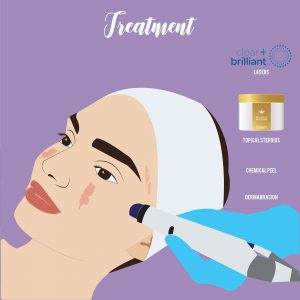What is Melasma?
Melasma is a form of hyperpigmentation, that is quite prevalent in women (men do sometimes get it too). It’s also known as chloasma, or the “mask of pregnancy” as it often occurs in pregnant women. The condition is thought to be triggered by UV exposure, as well as hormonal influences. Hormonal increases such as pregnancy, oral contraceptive usage, and other hormonal therapies play a significant role, and can make the situation worst. Melasma is difficult to treat, as it’s often time consuming, what works for one person doesn’t necessarily work for another, therefore its hard to pinpoint one effective treatment.

What are the symptoms of Melasma?
The sneaky Melasma likes to creep in and typically appears as symmetrical blotchy patches on the face, they are often a darker skin shade and can appear as brown, tan or blue-gray in colour. Melasma is commonly found on:
- Cheeks,
- Bridge of the nose,
- Forehead,
- Chin and
- Upper lip.
Sometimes it appears in less common areas of the body like the neck or forearms, especially in areas that are prone to sun exposure. The skin discolouration doesn’t do any physical harm, but you may feel self-conscious about the way it looks.
Melasma often occurs in women in their mid-30’s and continues to middle age. It may also start during the time of the pregnancy or during the use of oral contraceptives. After childbirth or after stopping oral contraceptives, melasma may improve but it never goes away completely.

What causes Melasma?
It isn’t totally clear what causes Melasma, both dark and fair skin individuals are at risk. The skin condition gets affected by estrogen and progesterone levels, this means that taking birth control pills, hormonal therapy and pregnancy does play a role. Stress and thyroid disease are other factors that could be the cause of Melasma.
If you suspect that you have Melasma, you can get it checked by using Visia Machine (wood’s lamp examination). It’s basically a light that detects bacterial or fungal skin infections, it can also be used to detect skin pigmentation disorders such as Melasma.

Things to avoid
While not all cases of Melasma will clear up with treatment, there are things that you can do to make sure the condition doesn’t get worst and to minimize the appearance of the discolouration. These include:
- Wearing sunscreen everyday with SPF 30
- Wearing a wide-brimmed hat that provides shade for your face
- Wearing protective clothing
Do note that Melasma might return without proper skincare and sun protection, so make sure you slap on plenty of SPF.

Treatment
Melasma is a tricky skin condition to treat, there are creams which only Dermatologist can prescribe which lightens the skin. The dermatologist may also prescribe topical steroids, chemical peels, dermabrasion, or lasers. Even though you get a custom-made plan from a dermatologist, it doesn’t guarantee that Melasma won’t come back. Along with the fore mentioned treatment, it’s important to minimize sun exposure by applying sunscreen daily.

Dr. Joyce personal recommendation:
BWMC VC Essence: Soak facial cotton with VC Essence and apply evenly on skin or dispense small amount on palms and pat directly on skin.
BWMC Brightening Cream: Apply evenly on entire face, use twice daily. Use with sunscreen for best results.
BWMC Pigmentation Cream: Apply on face after cleansing, use twice daily (for 3 months or as directed). Use with sunscreen for best results.
The bottom line is Melasma and hyperpigmentation is common but with proper precaution (lots of SPF), the skin condition can be avoided/ delayed.












